Fig 1. Overview of the general experimental procedure used in Study 1, 2 and 3.
All studies were composed by two sessions performed in two different days, separated about one week. During the first session photos of participants’ face were taken. Moreover, participants performed: the Heartbeat Counting task; a subscale (i.e. Noticing) of the Multidimensional Assessment of Interoceptive Awareness (MAIA) and the Self Localization task. During the second session participants performed in counterbalanced order the SELF task and the FRIEND task in Study 1 and 2 and the SELF task and the FAMOUS FACE task in Study 3. During these tasks, participants observed a series of morphed faces (their own one and their friend one morphed with two unknown models) flashing on the monitor for 8 seconds (Study 1 and 2) or two single morphed faces (their own one and a famous character one morphed with two unknown models) for 2 minutes (Study 3). Immediately after the flashing faces participants were instructed to rate on visual analogue scale (VAS), how much of the own/friend or famous person’s facial features they perceived in a list of morphed stimuli. The SELF and FRIEND/FAMOUS task were composed by three blocks. Each block was associated to a different ‘Flashing Rate’ of stimuli presentation. At the end of the SELF and FRIEND/FAMOUS FACE task participants were asked whether they were aware of the research questions and hypotheses, then they were debriefed by the experimenter. Participant appearing in the picture gave written informed consent to publish this figure.

